HA 3011 Advanced Financial Accounting: IFRS and Regulations
VerifiedAdded on 2023/06/11
|11
|2706
|71
Essay
AI Summary
This essay delves into various aspects of advanced financial accounting, including an analysis of the qualitative characteristics of financial reporting as outlined by the Australian Accounting Standards Board (AASB) and the International Financial Reporting Standards (IFRS). It examines the absence of understandability, comparability, and faithful representation in financial statements prepared under IFRS, based on opinions from finance professionals. The essay also discusses the Australian government's decision regarding regulations in the Corporations Act, dissecting this decision through public interest theory, capture theory, and the economic interest group theory of regulation. Furthermore, it analyzes the impact of the US FASB Statement No. 144 on the financial reporting of fixed assets. Finally, the essay explores the motivations for directors to revalue business assets and the potential effects of non-revaluation on the financial conditions of business entities and shareholder wealth. Desklib provides access to this document along with a wealth of study resources for students.
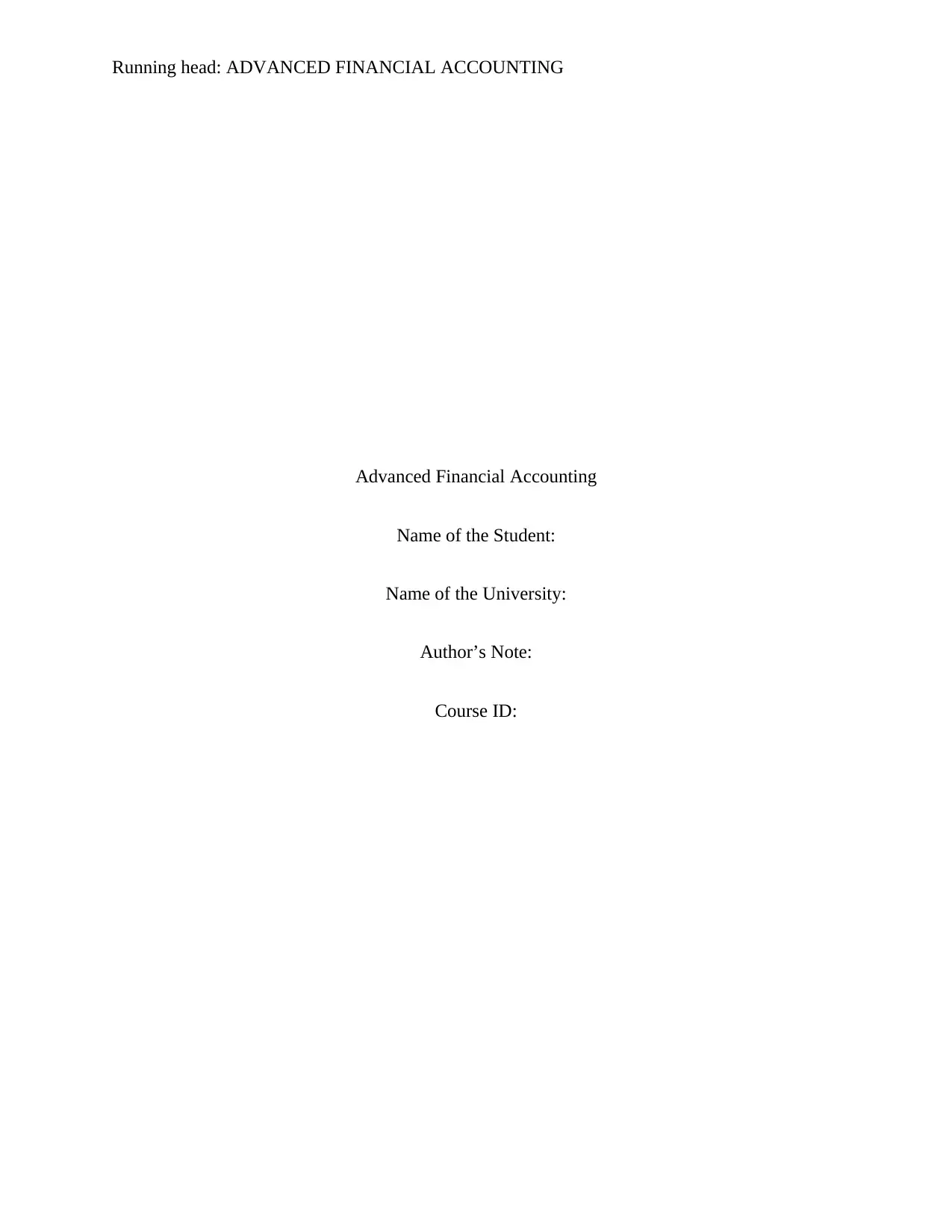
Running head: ADVANCED FINANCIAL ACCOUNTING
Advanced Financial Accounting
Name of the Student:
Name of the University:
Author’s Note:
Course ID:
Advanced Financial Accounting
Name of the Student:
Name of the University:
Author’s Note:
Course ID:
Paraphrase This Document
Need a fresh take? Get an instant paraphrase of this document with our AI Paraphraser
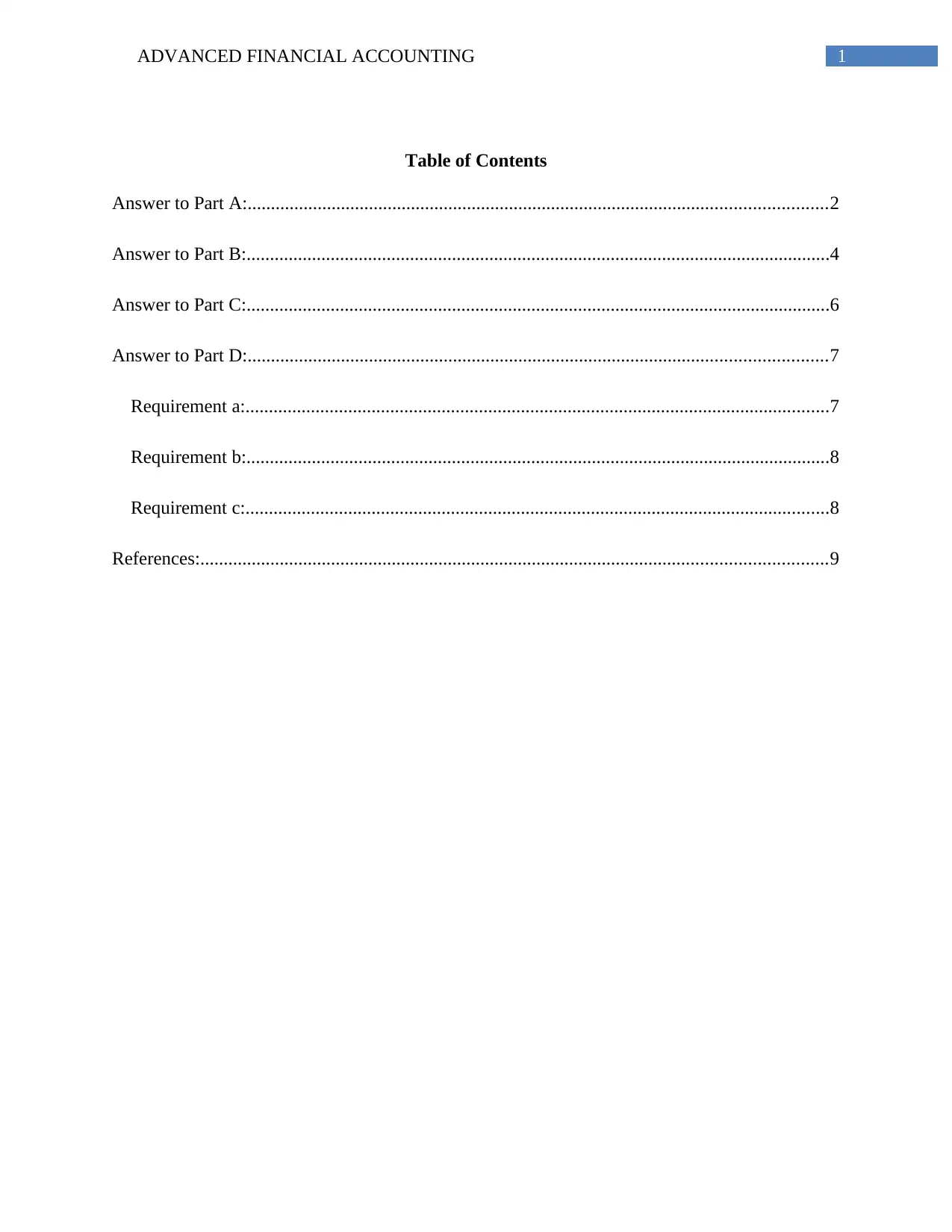
1ADVANCED FINANCIAL ACCOUNTING
Table of Contents
Answer to Part A:............................................................................................................................2
Answer to Part B:.............................................................................................................................4
Answer to Part C:.............................................................................................................................6
Answer to Part D:............................................................................................................................7
Requirement a:.............................................................................................................................7
Requirement b:.............................................................................................................................8
Requirement c:.............................................................................................................................8
References:......................................................................................................................................9
Table of Contents
Answer to Part A:............................................................................................................................2
Answer to Part B:.............................................................................................................................4
Answer to Part C:.............................................................................................................................6
Answer to Part D:............................................................................................................................7
Requirement a:.............................................................................................................................7
Requirement b:.............................................................................................................................8
Requirement c:.............................................................................................................................8
References:......................................................................................................................................9
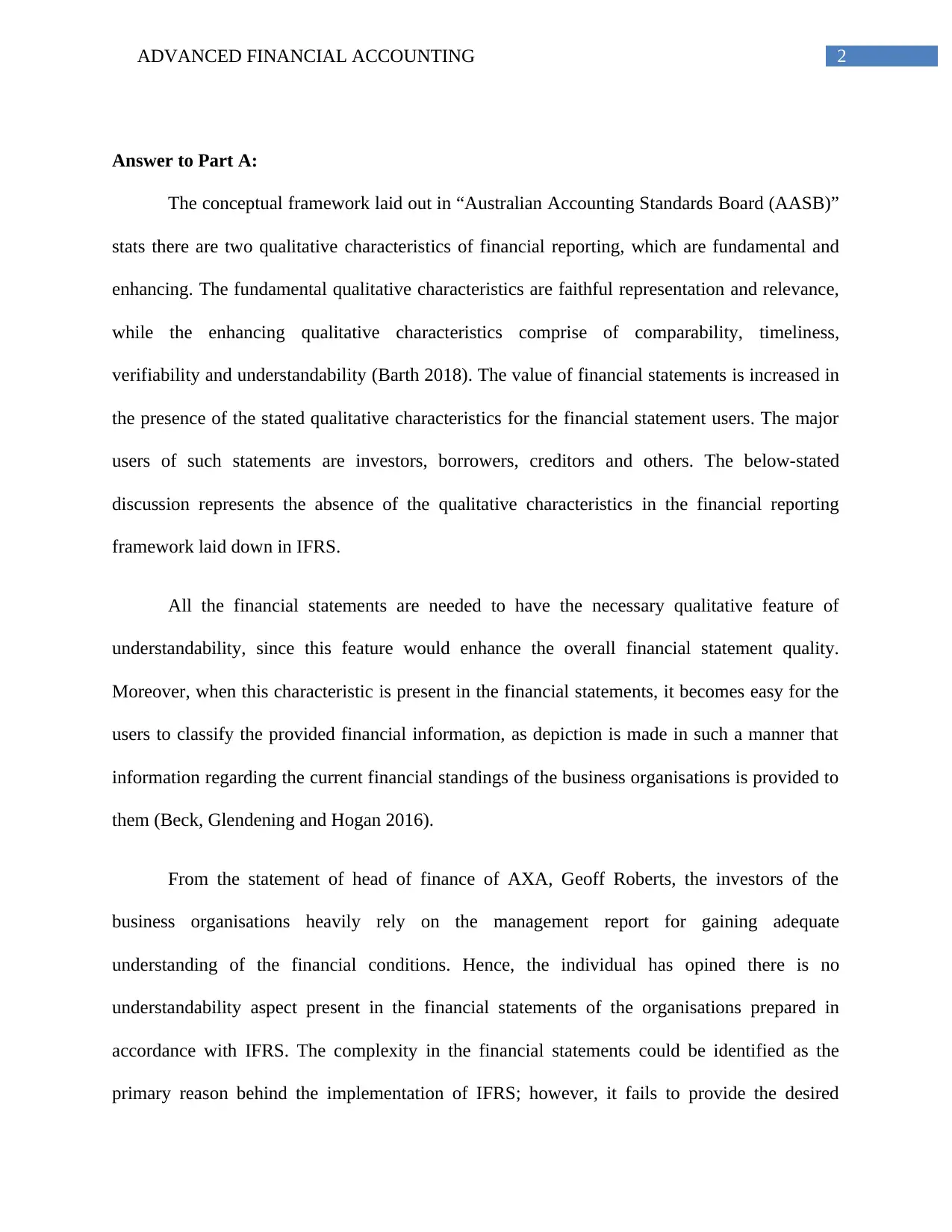
2ADVANCED FINANCIAL ACCOUNTING
Answer to Part A:
The conceptual framework laid out in “Australian Accounting Standards Board (AASB)”
stats there are two qualitative characteristics of financial reporting, which are fundamental and
enhancing. The fundamental qualitative characteristics are faithful representation and relevance,
while the enhancing qualitative characteristics comprise of comparability, timeliness,
verifiability and understandability (Barth 2018). The value of financial statements is increased in
the presence of the stated qualitative characteristics for the financial statement users. The major
users of such statements are investors, borrowers, creditors and others. The below-stated
discussion represents the absence of the qualitative characteristics in the financial reporting
framework laid down in IFRS.
All the financial statements are needed to have the necessary qualitative feature of
understandability, since this feature would enhance the overall financial statement quality.
Moreover, when this characteristic is present in the financial statements, it becomes easy for the
users to classify the provided financial information, as depiction is made in such a manner that
information regarding the current financial standings of the business organisations is provided to
them (Beck, Glendening and Hogan 2016).
From the statement of head of finance of AXA, Geoff Roberts, the investors of the
business organisations heavily rely on the management report for gaining adequate
understanding of the financial conditions. Hence, the individual has opined there is no
understandability aspect present in the financial statements of the organisations prepared in
accordance with IFRS. The complexity in the financial statements could be identified as the
primary reason behind the implementation of IFRS; however, it fails to provide the desired
Answer to Part A:
The conceptual framework laid out in “Australian Accounting Standards Board (AASB)”
stats there are two qualitative characteristics of financial reporting, which are fundamental and
enhancing. The fundamental qualitative characteristics are faithful representation and relevance,
while the enhancing qualitative characteristics comprise of comparability, timeliness,
verifiability and understandability (Barth 2018). The value of financial statements is increased in
the presence of the stated qualitative characteristics for the financial statement users. The major
users of such statements are investors, borrowers, creditors and others. The below-stated
discussion represents the absence of the qualitative characteristics in the financial reporting
framework laid down in IFRS.
All the financial statements are needed to have the necessary qualitative feature of
understandability, since this feature would enhance the overall financial statement quality.
Moreover, when this characteristic is present in the financial statements, it becomes easy for the
users to classify the provided financial information, as depiction is made in such a manner that
information regarding the current financial standings of the business organisations is provided to
them (Beck, Glendening and Hogan 2016).
From the statement of head of finance of AXA, Geoff Roberts, the investors of the
business organisations heavily rely on the management report for gaining adequate
understanding of the financial conditions. Hence, the individual has opined there is no
understandability aspect present in the financial statements of the organisations prepared in
accordance with IFRS. The complexity in the financial statements could be identified as the
primary reason behind the implementation of IFRS; however, it fails to provide the desired
You're viewing a preview
Unlock full access by subscribing today!
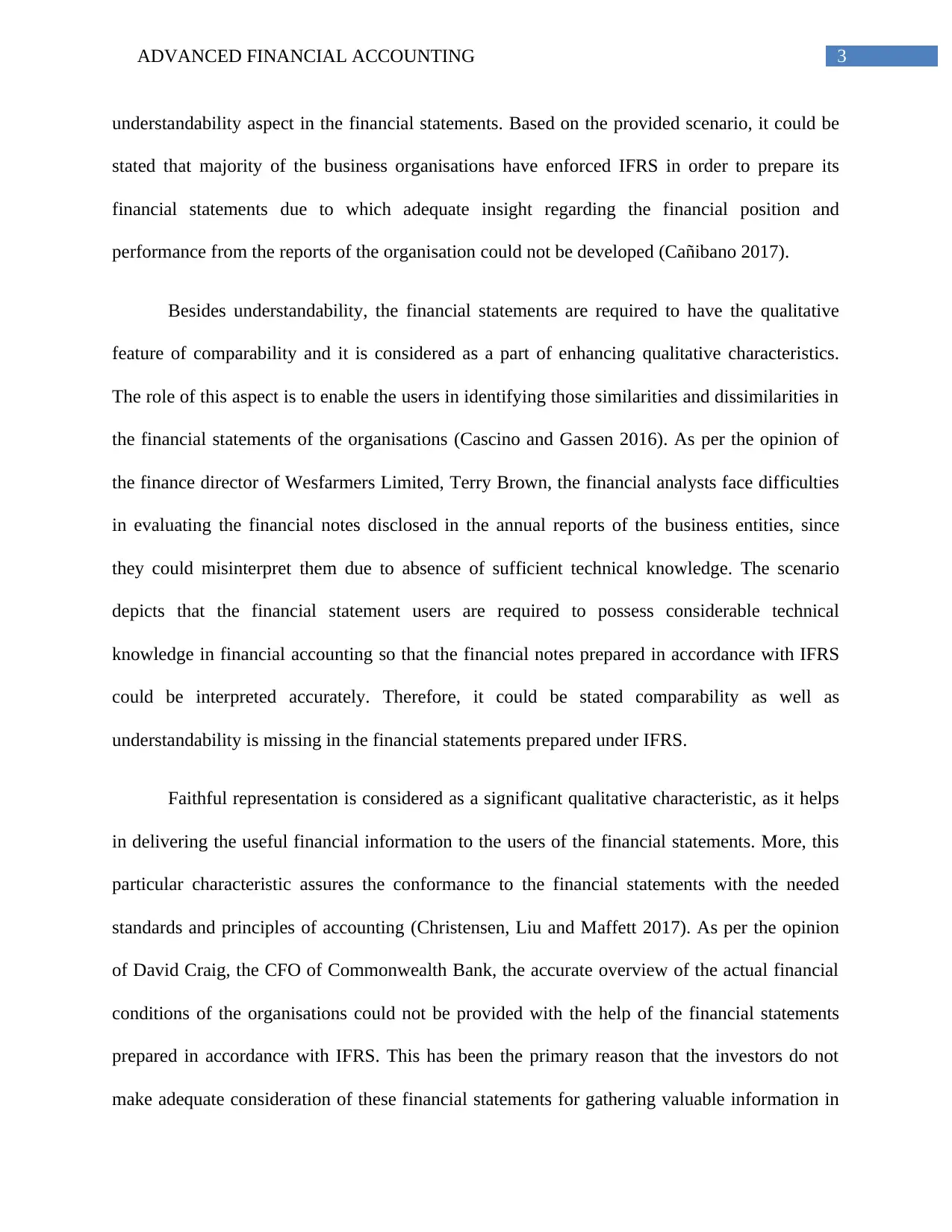
3ADVANCED FINANCIAL ACCOUNTING
understandability aspect in the financial statements. Based on the provided scenario, it could be
stated that majority of the business organisations have enforced IFRS in order to prepare its
financial statements due to which adequate insight regarding the financial position and
performance from the reports of the organisation could not be developed (Cañibano 2017).
Besides understandability, the financial statements are required to have the qualitative
feature of comparability and it is considered as a part of enhancing qualitative characteristics.
The role of this aspect is to enable the users in identifying those similarities and dissimilarities in
the financial statements of the organisations (Cascino and Gassen 2016). As per the opinion of
the finance director of Wesfarmers Limited, Terry Brown, the financial analysts face difficulties
in evaluating the financial notes disclosed in the annual reports of the business entities, since
they could misinterpret them due to absence of sufficient technical knowledge. The scenario
depicts that the financial statement users are required to possess considerable technical
knowledge in financial accounting so that the financial notes prepared in accordance with IFRS
could be interpreted accurately. Therefore, it could be stated comparability as well as
understandability is missing in the financial statements prepared under IFRS.
Faithful representation is considered as a significant qualitative characteristic, as it helps
in delivering the useful financial information to the users of the financial statements. More, this
particular characteristic assures the conformance to the financial statements with the needed
standards and principles of accounting (Christensen, Liu and Maffett 2017). As per the opinion
of David Craig, the CFO of Commonwealth Bank, the accurate overview of the actual financial
conditions of the organisations could not be provided with the help of the financial statements
prepared in accordance with IFRS. This has been the primary reason that the investors do not
make adequate consideration of these financial statements for gathering valuable information in
understandability aspect in the financial statements. Based on the provided scenario, it could be
stated that majority of the business organisations have enforced IFRS in order to prepare its
financial statements due to which adequate insight regarding the financial position and
performance from the reports of the organisation could not be developed (Cañibano 2017).
Besides understandability, the financial statements are required to have the qualitative
feature of comparability and it is considered as a part of enhancing qualitative characteristics.
The role of this aspect is to enable the users in identifying those similarities and dissimilarities in
the financial statements of the organisations (Cascino and Gassen 2016). As per the opinion of
the finance director of Wesfarmers Limited, Terry Brown, the financial analysts face difficulties
in evaluating the financial notes disclosed in the annual reports of the business entities, since
they could misinterpret them due to absence of sufficient technical knowledge. The scenario
depicts that the financial statement users are required to possess considerable technical
knowledge in financial accounting so that the financial notes prepared in accordance with IFRS
could be interpreted accurately. Therefore, it could be stated comparability as well as
understandability is missing in the financial statements prepared under IFRS.
Faithful representation is considered as a significant qualitative characteristic, as it helps
in delivering the useful financial information to the users of the financial statements. More, this
particular characteristic assures the conformance to the financial statements with the needed
standards and principles of accounting (Christensen, Liu and Maffett 2017). As per the opinion
of David Craig, the CFO of Commonwealth Bank, the accurate overview of the actual financial
conditions of the organisations could not be provided with the help of the financial statements
prepared in accordance with IFRS. This has been the primary reason that the investors do not
make adequate consideration of these financial statements for gathering valuable information in
Paraphrase This Document
Need a fresh take? Get an instant paraphrase of this document with our AI Paraphraser
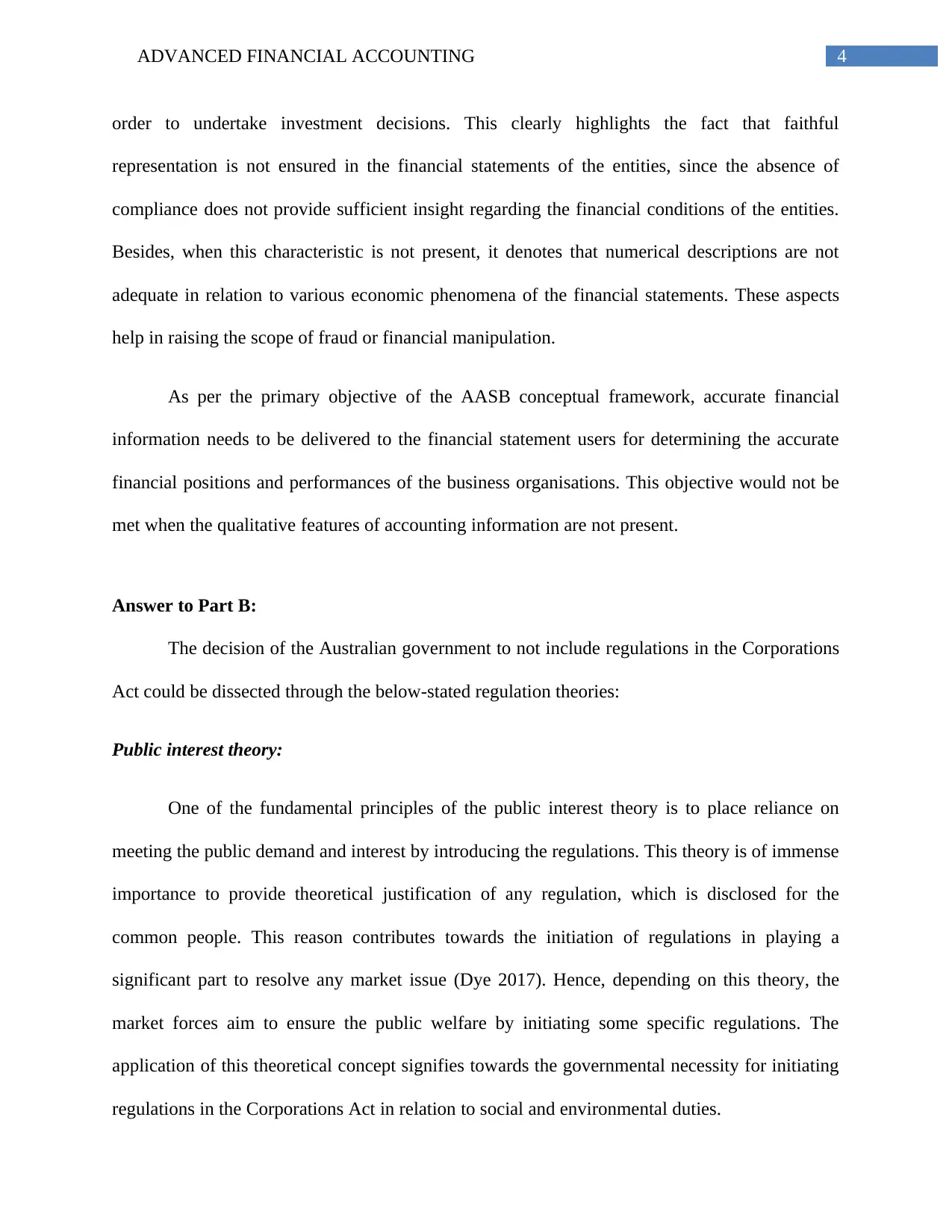
4ADVANCED FINANCIAL ACCOUNTING
order to undertake investment decisions. This clearly highlights the fact that faithful
representation is not ensured in the financial statements of the entities, since the absence of
compliance does not provide sufficient insight regarding the financial conditions of the entities.
Besides, when this characteristic is not present, it denotes that numerical descriptions are not
adequate in relation to various economic phenomena of the financial statements. These aspects
help in raising the scope of fraud or financial manipulation.
As per the primary objective of the AASB conceptual framework, accurate financial
information needs to be delivered to the financial statement users for determining the accurate
financial positions and performances of the business organisations. This objective would not be
met when the qualitative features of accounting information are not present.
Answer to Part B:
The decision of the Australian government to not include regulations in the Corporations
Act could be dissected through the below-stated regulation theories:
Public interest theory:
One of the fundamental principles of the public interest theory is to place reliance on
meeting the public demand and interest by introducing the regulations. This theory is of immense
importance to provide theoretical justification of any regulation, which is disclosed for the
common people. This reason contributes towards the initiation of regulations in playing a
significant part to resolve any market issue (Dye 2017). Hence, depending on this theory, the
market forces aim to ensure the public welfare by initiating some specific regulations. The
application of this theoretical concept signifies towards the governmental necessity for initiating
regulations in the Corporations Act in relation to social and environmental duties.
order to undertake investment decisions. This clearly highlights the fact that faithful
representation is not ensured in the financial statements of the entities, since the absence of
compliance does not provide sufficient insight regarding the financial conditions of the entities.
Besides, when this characteristic is not present, it denotes that numerical descriptions are not
adequate in relation to various economic phenomena of the financial statements. These aspects
help in raising the scope of fraud or financial manipulation.
As per the primary objective of the AASB conceptual framework, accurate financial
information needs to be delivered to the financial statement users for determining the accurate
financial positions and performances of the business organisations. This objective would not be
met when the qualitative features of accounting information are not present.
Answer to Part B:
The decision of the Australian government to not include regulations in the Corporations
Act could be dissected through the below-stated regulation theories:
Public interest theory:
One of the fundamental principles of the public interest theory is to place reliance on
meeting the public demand and interest by introducing the regulations. This theory is of immense
importance to provide theoretical justification of any regulation, which is disclosed for the
common people. This reason contributes towards the initiation of regulations in playing a
significant part to resolve any market issue (Dye 2017). Hence, depending on this theory, the
market forces aim to ensure the public welfare by initiating some specific regulations. The
application of this theoretical concept signifies towards the governmental necessity for initiating
regulations in the Corporations Act in relation to social and environmental duties.
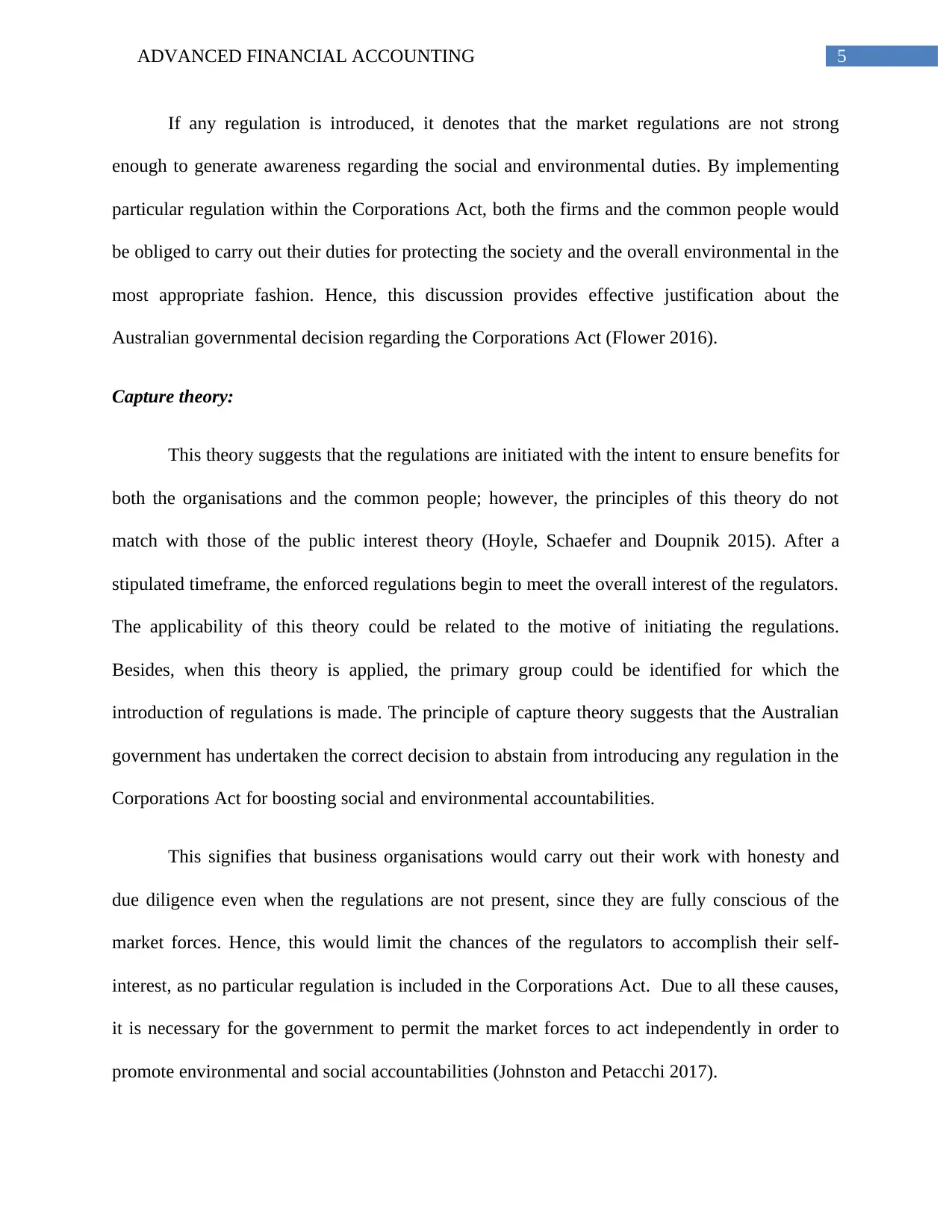
5ADVANCED FINANCIAL ACCOUNTING
If any regulation is introduced, it denotes that the market regulations are not strong
enough to generate awareness regarding the social and environmental duties. By implementing
particular regulation within the Corporations Act, both the firms and the common people would
be obliged to carry out their duties for protecting the society and the overall environmental in the
most appropriate fashion. Hence, this discussion provides effective justification about the
Australian governmental decision regarding the Corporations Act (Flower 2016).
Capture theory:
This theory suggests that the regulations are initiated with the intent to ensure benefits for
both the organisations and the common people; however, the principles of this theory do not
match with those of the public interest theory (Hoyle, Schaefer and Doupnik 2015). After a
stipulated timeframe, the enforced regulations begin to meet the overall interest of the regulators.
The applicability of this theory could be related to the motive of initiating the regulations.
Besides, when this theory is applied, the primary group could be identified for which the
introduction of regulations is made. The principle of capture theory suggests that the Australian
government has undertaken the correct decision to abstain from introducing any regulation in the
Corporations Act for boosting social and environmental accountabilities.
This signifies that business organisations would carry out their work with honesty and
due diligence even when the regulations are not present, since they are fully conscious of the
market forces. Hence, this would limit the chances of the regulators to accomplish their self-
interest, as no particular regulation is included in the Corporations Act. Due to all these causes,
it is necessary for the government to permit the market forces to act independently in order to
promote environmental and social accountabilities (Johnston and Petacchi 2017).
If any regulation is introduced, it denotes that the market regulations are not strong
enough to generate awareness regarding the social and environmental duties. By implementing
particular regulation within the Corporations Act, both the firms and the common people would
be obliged to carry out their duties for protecting the society and the overall environmental in the
most appropriate fashion. Hence, this discussion provides effective justification about the
Australian governmental decision regarding the Corporations Act (Flower 2016).
Capture theory:
This theory suggests that the regulations are initiated with the intent to ensure benefits for
both the organisations and the common people; however, the principles of this theory do not
match with those of the public interest theory (Hoyle, Schaefer and Doupnik 2015). After a
stipulated timeframe, the enforced regulations begin to meet the overall interest of the regulators.
The applicability of this theory could be related to the motive of initiating the regulations.
Besides, when this theory is applied, the primary group could be identified for which the
introduction of regulations is made. The principle of capture theory suggests that the Australian
government has undertaken the correct decision to abstain from introducing any regulation in the
Corporations Act for boosting social and environmental accountabilities.
This signifies that business organisations would carry out their work with honesty and
due diligence even when the regulations are not present, since they are fully conscious of the
market forces. Hence, this would limit the chances of the regulators to accomplish their self-
interest, as no particular regulation is included in the Corporations Act. Due to all these causes,
it is necessary for the government to permit the market forces to act independently in order to
promote environmental and social accountabilities (Johnston and Petacchi 2017).
You're viewing a preview
Unlock full access by subscribing today!
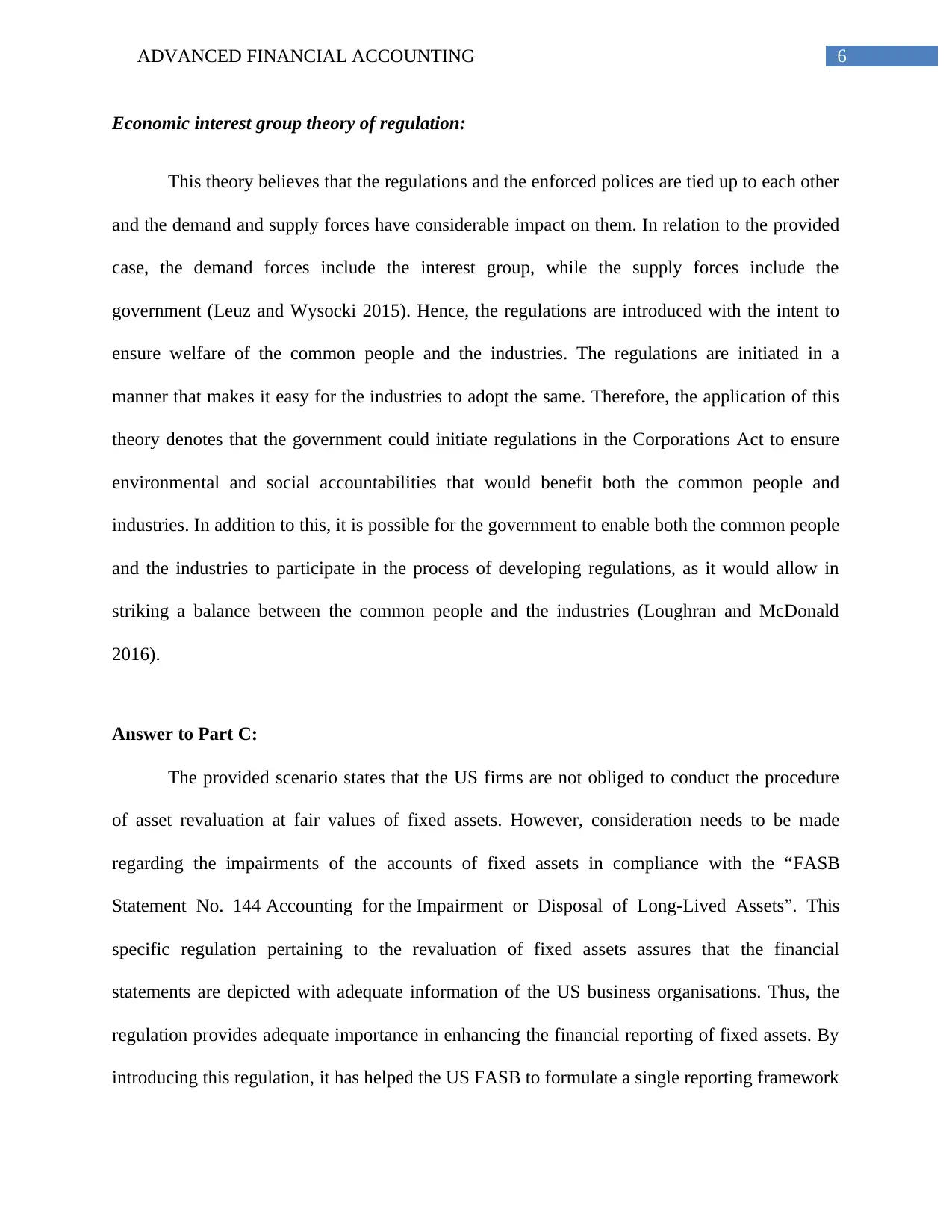
6ADVANCED FINANCIAL ACCOUNTING
Economic interest group theory of regulation:
This theory believes that the regulations and the enforced polices are tied up to each other
and the demand and supply forces have considerable impact on them. In relation to the provided
case, the demand forces include the interest group, while the supply forces include the
government (Leuz and Wysocki 2015). Hence, the regulations are introduced with the intent to
ensure welfare of the common people and the industries. The regulations are initiated in a
manner that makes it easy for the industries to adopt the same. Therefore, the application of this
theory denotes that the government could initiate regulations in the Corporations Act to ensure
environmental and social accountabilities that would benefit both the common people and
industries. In addition to this, it is possible for the government to enable both the common people
and the industries to participate in the process of developing regulations, as it would allow in
striking a balance between the common people and the industries (Loughran and McDonald
2016).
Answer to Part C:
The provided scenario states that the US firms are not obliged to conduct the procedure
of asset revaluation at fair values of fixed assets. However, consideration needs to be made
regarding the impairments of the accounts of fixed assets in compliance with the “FASB
Statement No. 144 Accounting for the Impairment or Disposal of Long-Lived Assets”. This
specific regulation pertaining to the revaluation of fixed assets assures that the financial
statements are depicted with adequate information of the US business organisations. Thus, the
regulation provides adequate importance in enhancing the financial reporting of fixed assets. By
introducing this regulation, it has helped the US FASB to formulate a single reporting framework
Economic interest group theory of regulation:
This theory believes that the regulations and the enforced polices are tied up to each other
and the demand and supply forces have considerable impact on them. In relation to the provided
case, the demand forces include the interest group, while the supply forces include the
government (Leuz and Wysocki 2015). Hence, the regulations are introduced with the intent to
ensure welfare of the common people and the industries. The regulations are initiated in a
manner that makes it easy for the industries to adopt the same. Therefore, the application of this
theory denotes that the government could initiate regulations in the Corporations Act to ensure
environmental and social accountabilities that would benefit both the common people and
industries. In addition to this, it is possible for the government to enable both the common people
and the industries to participate in the process of developing regulations, as it would allow in
striking a balance between the common people and the industries (Loughran and McDonald
2016).
Answer to Part C:
The provided scenario states that the US firms are not obliged to conduct the procedure
of asset revaluation at fair values of fixed assets. However, consideration needs to be made
regarding the impairments of the accounts of fixed assets in compliance with the “FASB
Statement No. 144 Accounting for the Impairment or Disposal of Long-Lived Assets”. This
specific regulation pertaining to the revaluation of fixed assets assures that the financial
statements are depicted with adequate information of the US business organisations. Thus, the
regulation provides adequate importance in enhancing the financial reporting of fixed assets. By
introducing this regulation, it has helped the US FASB to formulate a single reporting framework
Paraphrase This Document
Need a fresh take? Get an instant paraphrase of this document with our AI Paraphraser
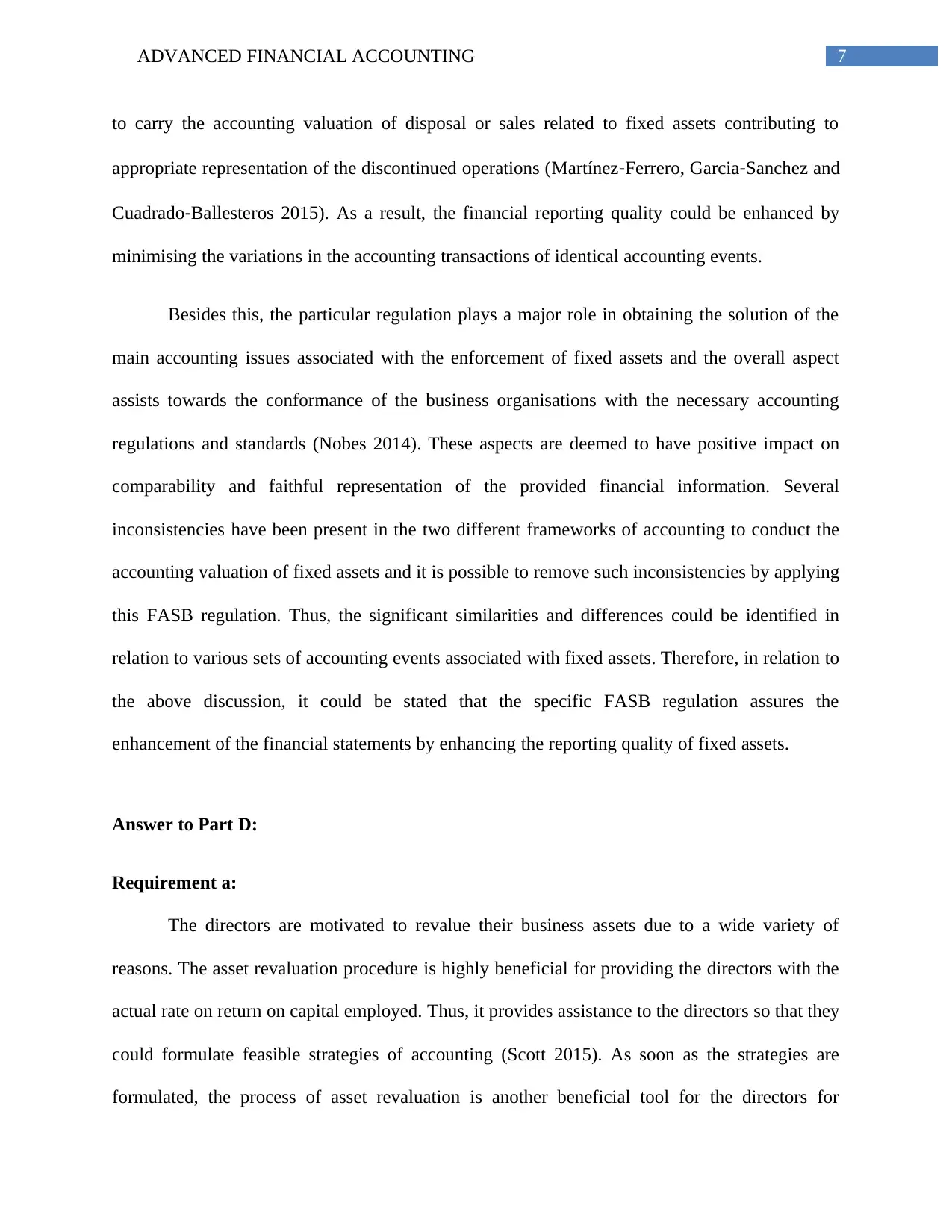
7ADVANCED FINANCIAL ACCOUNTING
to carry the accounting valuation of disposal or sales related to fixed assets contributing to
appropriate representation of the discontinued operations (Martínez‐Ferrero, Garcia‐Sanchez and
Cuadrado‐Ballesteros 2015). As a result, the financial reporting quality could be enhanced by
minimising the variations in the accounting transactions of identical accounting events.
Besides this, the particular regulation plays a major role in obtaining the solution of the
main accounting issues associated with the enforcement of fixed assets and the overall aspect
assists towards the conformance of the business organisations with the necessary accounting
regulations and standards (Nobes 2014). These aspects are deemed to have positive impact on
comparability and faithful representation of the provided financial information. Several
inconsistencies have been present in the two different frameworks of accounting to conduct the
accounting valuation of fixed assets and it is possible to remove such inconsistencies by applying
this FASB regulation. Thus, the significant similarities and differences could be identified in
relation to various sets of accounting events associated with fixed assets. Therefore, in relation to
the above discussion, it could be stated that the specific FASB regulation assures the
enhancement of the financial statements by enhancing the reporting quality of fixed assets.
Answer to Part D:
Requirement a:
The directors are motivated to revalue their business assets due to a wide variety of
reasons. The asset revaluation procedure is highly beneficial for providing the directors with the
actual rate on return on capital employed. Thus, it provides assistance to the directors so that they
could formulate feasible strategies of accounting (Scott 2015). As soon as the strategies are
formulated, the process of asset revaluation is another beneficial tool for the directors for
to carry the accounting valuation of disposal or sales related to fixed assets contributing to
appropriate representation of the discontinued operations (Martínez‐Ferrero, Garcia‐Sanchez and
Cuadrado‐Ballesteros 2015). As a result, the financial reporting quality could be enhanced by
minimising the variations in the accounting transactions of identical accounting events.
Besides this, the particular regulation plays a major role in obtaining the solution of the
main accounting issues associated with the enforcement of fixed assets and the overall aspect
assists towards the conformance of the business organisations with the necessary accounting
regulations and standards (Nobes 2014). These aspects are deemed to have positive impact on
comparability and faithful representation of the provided financial information. Several
inconsistencies have been present in the two different frameworks of accounting to conduct the
accounting valuation of fixed assets and it is possible to remove such inconsistencies by applying
this FASB regulation. Thus, the significant similarities and differences could be identified in
relation to various sets of accounting events associated with fixed assets. Therefore, in relation to
the above discussion, it could be stated that the specific FASB regulation assures the
enhancement of the financial statements by enhancing the reporting quality of fixed assets.
Answer to Part D:
Requirement a:
The directors are motivated to revalue their business assets due to a wide variety of
reasons. The asset revaluation procedure is highly beneficial for providing the directors with the
actual rate on return on capital employed. Thus, it provides assistance to the directors so that they
could formulate feasible strategies of accounting (Scott 2015). As soon as the strategies are
formulated, the process of asset revaluation is another beneficial tool for the directors for
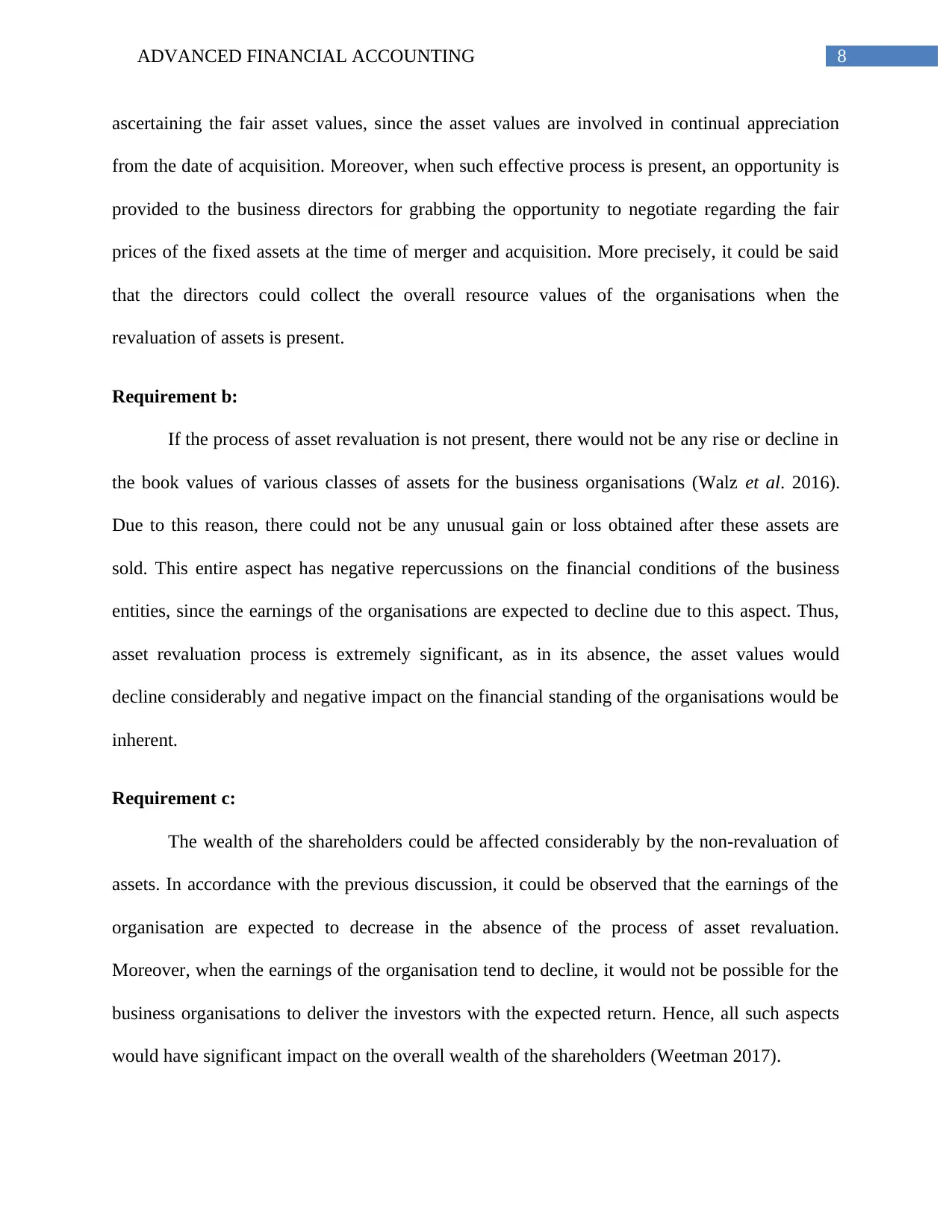
8ADVANCED FINANCIAL ACCOUNTING
ascertaining the fair asset values, since the asset values are involved in continual appreciation
from the date of acquisition. Moreover, when such effective process is present, an opportunity is
provided to the business directors for grabbing the opportunity to negotiate regarding the fair
prices of the fixed assets at the time of merger and acquisition. More precisely, it could be said
that the directors could collect the overall resource values of the organisations when the
revaluation of assets is present.
Requirement b:
If the process of asset revaluation is not present, there would not be any rise or decline in
the book values of various classes of assets for the business organisations (Walz et al. 2016).
Due to this reason, there could not be any unusual gain or loss obtained after these assets are
sold. This entire aspect has negative repercussions on the financial conditions of the business
entities, since the earnings of the organisations are expected to decline due to this aspect. Thus,
asset revaluation process is extremely significant, as in its absence, the asset values would
decline considerably and negative impact on the financial standing of the organisations would be
inherent.
Requirement c:
The wealth of the shareholders could be affected considerably by the non-revaluation of
assets. In accordance with the previous discussion, it could be observed that the earnings of the
organisation are expected to decrease in the absence of the process of asset revaluation.
Moreover, when the earnings of the organisation tend to decline, it would not be possible for the
business organisations to deliver the investors with the expected return. Hence, all such aspects
would have significant impact on the overall wealth of the shareholders (Weetman 2017).
ascertaining the fair asset values, since the asset values are involved in continual appreciation
from the date of acquisition. Moreover, when such effective process is present, an opportunity is
provided to the business directors for grabbing the opportunity to negotiate regarding the fair
prices of the fixed assets at the time of merger and acquisition. More precisely, it could be said
that the directors could collect the overall resource values of the organisations when the
revaluation of assets is present.
Requirement b:
If the process of asset revaluation is not present, there would not be any rise or decline in
the book values of various classes of assets for the business organisations (Walz et al. 2016).
Due to this reason, there could not be any unusual gain or loss obtained after these assets are
sold. This entire aspect has negative repercussions on the financial conditions of the business
entities, since the earnings of the organisations are expected to decline due to this aspect. Thus,
asset revaluation process is extremely significant, as in its absence, the asset values would
decline considerably and negative impact on the financial standing of the organisations would be
inherent.
Requirement c:
The wealth of the shareholders could be affected considerably by the non-revaluation of
assets. In accordance with the previous discussion, it could be observed that the earnings of the
organisation are expected to decrease in the absence of the process of asset revaluation.
Moreover, when the earnings of the organisation tend to decline, it would not be possible for the
business organisations to deliver the investors with the expected return. Hence, all such aspects
would have significant impact on the overall wealth of the shareholders (Weetman 2017).
You're viewing a preview
Unlock full access by subscribing today!
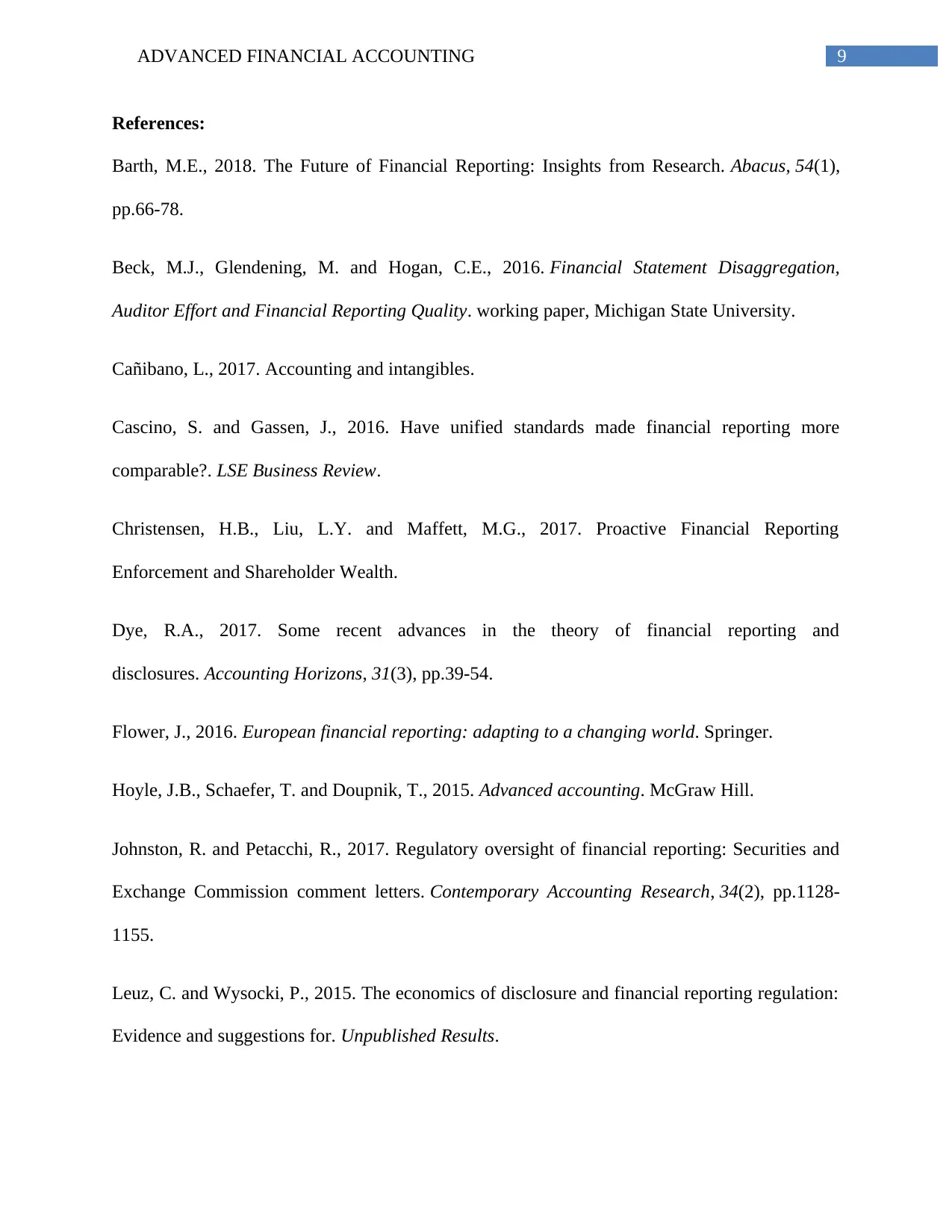
9ADVANCED FINANCIAL ACCOUNTING
References:
Barth, M.E., 2018. The Future of Financial Reporting: Insights from Research. Abacus, 54(1),
pp.66-78.
Beck, M.J., Glendening, M. and Hogan, C.E., 2016. Financial Statement Disaggregation,
Auditor Effort and Financial Reporting Quality. working paper, Michigan State University.
Cañibano, L., 2017. Accounting and intangibles.
Cascino, S. and Gassen, J., 2016. Have unified standards made financial reporting more
comparable?. LSE Business Review.
Christensen, H.B., Liu, L.Y. and Maffett, M.G., 2017. Proactive Financial Reporting
Enforcement and Shareholder Wealth.
Dye, R.A., 2017. Some recent advances in the theory of financial reporting and
disclosures. Accounting Horizons, 31(3), pp.39-54.
Flower, J., 2016. European financial reporting: adapting to a changing world. Springer.
Hoyle, J.B., Schaefer, T. and Doupnik, T., 2015. Advanced accounting. McGraw Hill.
Johnston, R. and Petacchi, R., 2017. Regulatory oversight of financial reporting: Securities and
Exchange Commission comment letters. Contemporary Accounting Research, 34(2), pp.1128-
1155.
Leuz, C. and Wysocki, P., 2015. The economics of disclosure and financial reporting regulation:
Evidence and suggestions for. Unpublished Results.
References:
Barth, M.E., 2018. The Future of Financial Reporting: Insights from Research. Abacus, 54(1),
pp.66-78.
Beck, M.J., Glendening, M. and Hogan, C.E., 2016. Financial Statement Disaggregation,
Auditor Effort and Financial Reporting Quality. working paper, Michigan State University.
Cañibano, L., 2017. Accounting and intangibles.
Cascino, S. and Gassen, J., 2016. Have unified standards made financial reporting more
comparable?. LSE Business Review.
Christensen, H.B., Liu, L.Y. and Maffett, M.G., 2017. Proactive Financial Reporting
Enforcement and Shareholder Wealth.
Dye, R.A., 2017. Some recent advances in the theory of financial reporting and
disclosures. Accounting Horizons, 31(3), pp.39-54.
Flower, J., 2016. European financial reporting: adapting to a changing world. Springer.
Hoyle, J.B., Schaefer, T. and Doupnik, T., 2015. Advanced accounting. McGraw Hill.
Johnston, R. and Petacchi, R., 2017. Regulatory oversight of financial reporting: Securities and
Exchange Commission comment letters. Contemporary Accounting Research, 34(2), pp.1128-
1155.
Leuz, C. and Wysocki, P., 2015. The economics of disclosure and financial reporting regulation:
Evidence and suggestions for. Unpublished Results.
Paraphrase This Document
Need a fresh take? Get an instant paraphrase of this document with our AI Paraphraser
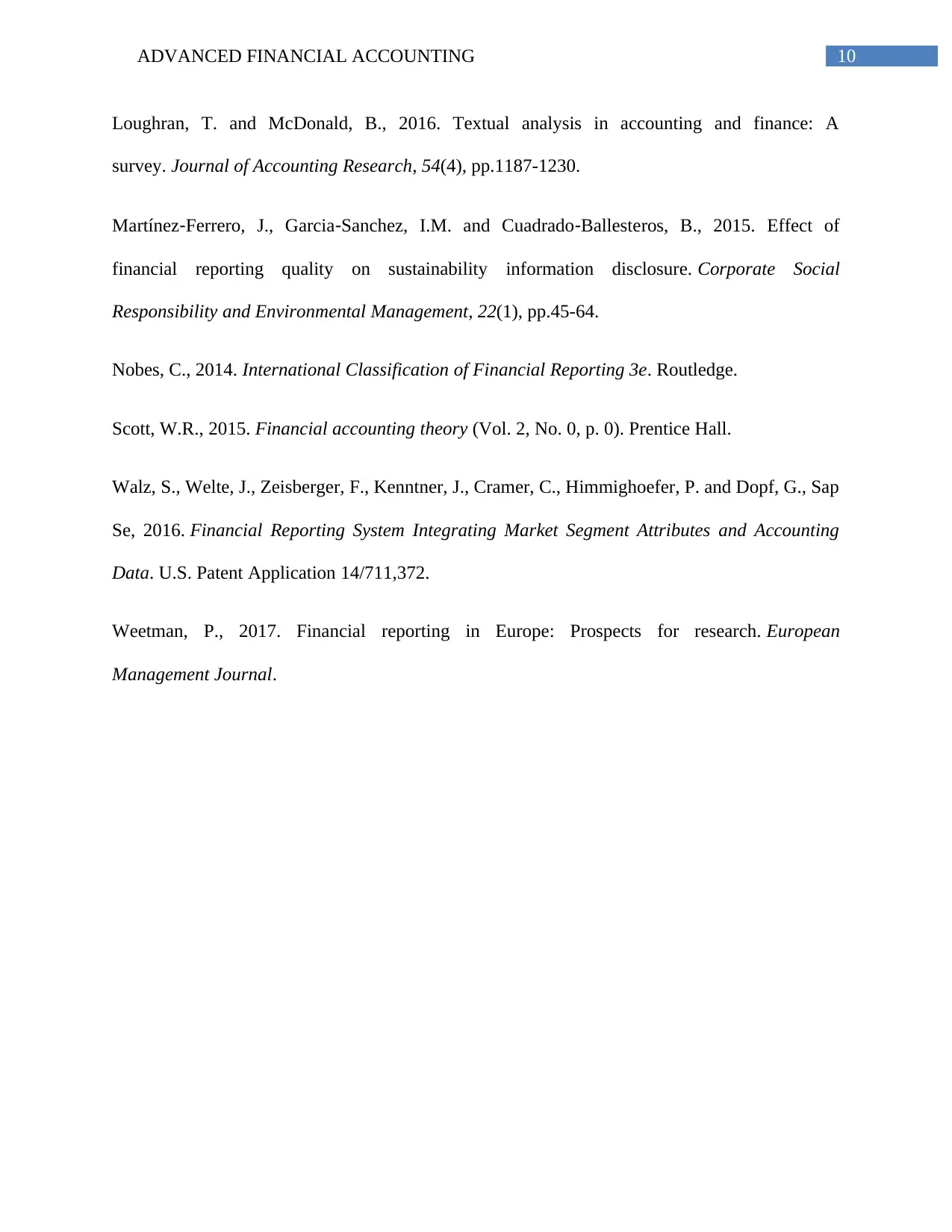
10ADVANCED FINANCIAL ACCOUNTING
Loughran, T. and McDonald, B., 2016. Textual analysis in accounting and finance: A
survey. Journal of Accounting Research, 54(4), pp.1187-1230.
Martínez‐Ferrero, J., Garcia‐Sanchez, I.M. and Cuadrado‐Ballesteros, B., 2015. Effect of
financial reporting quality on sustainability information disclosure. Corporate Social
Responsibility and Environmental Management, 22(1), pp.45-64.
Nobes, C., 2014. International Classification of Financial Reporting 3e. Routledge.
Scott, W.R., 2015. Financial accounting theory (Vol. 2, No. 0, p. 0). Prentice Hall.
Walz, S., Welte, J., Zeisberger, F., Kenntner, J., Cramer, C., Himmighoefer, P. and Dopf, G., Sap
Se, 2016. Financial Reporting System Integrating Market Segment Attributes and Accounting
Data. U.S. Patent Application 14/711,372.
Weetman, P., 2017. Financial reporting in Europe: Prospects for research. European
Management Journal.
Loughran, T. and McDonald, B., 2016. Textual analysis in accounting and finance: A
survey. Journal of Accounting Research, 54(4), pp.1187-1230.
Martínez‐Ferrero, J., Garcia‐Sanchez, I.M. and Cuadrado‐Ballesteros, B., 2015. Effect of
financial reporting quality on sustainability information disclosure. Corporate Social
Responsibility and Environmental Management, 22(1), pp.45-64.
Nobes, C., 2014. International Classification of Financial Reporting 3e. Routledge.
Scott, W.R., 2015. Financial accounting theory (Vol. 2, No. 0, p. 0). Prentice Hall.
Walz, S., Welte, J., Zeisberger, F., Kenntner, J., Cramer, C., Himmighoefer, P. and Dopf, G., Sap
Se, 2016. Financial Reporting System Integrating Market Segment Attributes and Accounting
Data. U.S. Patent Application 14/711,372.
Weetman, P., 2017. Financial reporting in Europe: Prospects for research. European
Management Journal.
1 out of 11
Related Documents
Your All-in-One AI-Powered Toolkit for Academic Success.
+13062052269
info@desklib.com
Available 24*7 on WhatsApp / Email
![[object Object]](/_next/static/media/star-bottom.7253800d.svg)
Unlock your academic potential
© 2024 | Zucol Services PVT LTD | All rights reserved.




